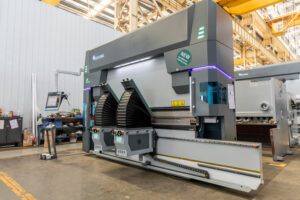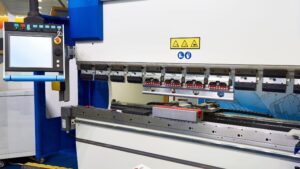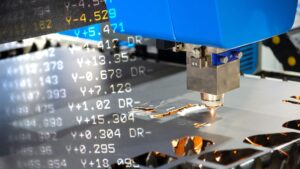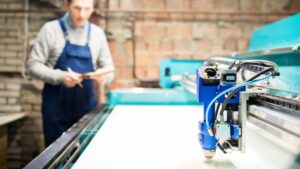As someone looking for the different types of CNC control system units, you should know what it actually is and how it functions. Simply put, the abbreviation CNC is short for Computer Numerical Control.
In the case of most programs, the CNC control system is in charge of managing the motion and speed of the machine tools used in everyday industrial processes. This is why they are often referred to as CNC control systems.
What is a CNC Control System?
Before we delve deeper into the main topic, let us first understand what CNC Control Systems are.
CNC or Computer Numerical Control system is a type of technology that helps feed information into a manufacturing machine to inform it about what it has to do.
It is a means to automate these manufacturing machines with software embedded microcomputers that are attached to these machines.
What is the general structure of a CNC machine?
As far as the basic outline goes, here are a few unavoidable components of the CNC machine that you should know about for a better understanding of how the different types of machine function.
Input devices
The input devices are used for the proper input methods of the part program into the CNC machine itself. Most commonly, the industries make use of three different input devices, which are the punch tape reader, magnetic tape reader, and the computer, via RS-232-C communication. This is subject to variation depending upon the specific endeavors and concerns pertaining to individual companies.
For each product that the machine makes, you need to input a custom program for it. The language used for this is a standard international language called the G-code. The G-code programming allows the machine to know specific data about how the product is supposed to be.
Machine control unit (MCY)
The machine control unit or the MCY in short. This is referred to as the heart of the machine, and it is definitely a very apt nickname. This part of the CNC system is responsible for all the mainstream controlling activities demonstrated by the machine per se.
The general functions can be listed as follows.
- Reading the coded information which is being fed
- Decoding the coded info
- Implementation of complex techniques like interpolation for the generation of axis motion commands
- Reception of feedback signals for position and speed pertaining to each drive axis
- Implementation of auxiliary control functions inclusive of coolant, spindle on and off, tool change, and more
Machine tools
Machine tools are an essential component of the toolkits for CNC control units. These machine tools are seen to be controlled on the X and Y axes, while the spindle is being controlled on the Z-axis.
Driving System
The driving system, includes amplifier circuits, drove motors, and ball lead screws.
Feedback systems
Feedback systems, act as transducers or sensors, thus forming a measuring system of sorts. These transducers include both positions and speed-specific ones and are dedicated to continuously monitoring the position and speed of the cutting tools in question.
Display unit
Display unit, which shows all the required data and commands which are being fed into the control system.
What are the Different types of CNC control systems?
Along with the constant progression of CNC systems and their utilization within the renowned industries, there has been quite an amount of research and thought put into the field.
This led to the development of a wide range of machines, which differ extensively either in their general functioning or their specific direction of work.
That being said, industrialists, these days are provided with a wide variety of CNC control systems to choose from.
Generally, CNC control systems can be divided based on the following factors:
- Number of axes
- Motion type
- Control loop
Here are a few of the most popular ones in the market as of now, with a brief explanation of their working and advantages.
1. Motion type CNC
Motion type CNC control system units are further divided into two main types, which are
Contouring systems
These machine tools are known to work in a continuous path where they focus on cutting the material presented to them and following its contour as such. Their basic functioning is inclusive of processes like luke milling, lathe, and routing machines.
These contouring machines function through the simulatory movement of the tool and work positions. Both the position f the machine as well as the product are controlled by the control system.
Point to point control systems
In this case, both the workpiece and the tool are kept in a constant position while the tool performs its required duty. The major members of such machines which function through point-to-point mechanisms include drilling machines, tapping machines, boring machines, and more.
By not moving the pieces unnecessarily in between the work process, these machines ensure safe and proper completion of work and minimize the margin for error significantly.
2. Loop control CNC systems
This part of the classification further branches into two depending upon the looping system involved in the procedure.
Closed-loop systems
This type of CNC control system works through a process that has feedback from the control system sent to the actual and programmed input. This is why it is referred to as a closed-loop system.
In this case of a CNC control system working under the servo mechanism, the feedback can be possibly measured through either analog or digital systems. With such closed-loop systems, you achieve high levels of power and accuracy thanks to their extensive capability and monitoring.
Open-loop systems
Here, the instructions are sent into the control via the input device, which is then converted to the signals by the controller. These converted signals are then sent to the servo amplifiers to energize the motors.
3. Number of axis type CNC control systems
This is a rather extensive segment of the CNC control system classification and is inclusive of 5 sub-classes of highly competent machine systems. The only thing varying in these devices is the number of axes which is clear from the name itself. However, this difference is all it takes to create notable changes in how it can complement your business specifically.
Putting it plainly, one can safely assume that the number of axes in which your CNC machine works should be a direct reflection of the requirements and expectations you would like to be fulfilled by your CNC control system. This is subject to great degrees of variation with every process in the industrial and business sector.
Two-axis control system
These machines allow you to access only 2 axes. A good example would be the lathe machine, where work is done only on the X and Y axes.
Two and a half axis control system
Though these machines possess three axes, movement is still not possible in all three of them. In these cases, the X and Y axes are firstly in position while the third axis comes into effect later.
Three-axis control system
As the name simply suggests, these machines work across three axes, mostly the X-axis, Y-axis, and the Z-axis simultaneously. They work with high levels of accuracy and precision and are limited to simple jobs and straightforward applications.
Four-axis control system
Along with the three common axes, an additional rotation axis known as the B-axis comes into play. This machine could either be a vertical machine or a horizontal machine.
Five-axis control system
They are three-axis machines with additional rotational axes in both Y and Z directions, alternatively called the A and B axes. Such machine systems get improved access to the undercuts and deep pockets.
Conclusion
To wrap things up, there are a few very important basic things to keep in mind while you choose your CNC systems. Though it might seem like a trivial task, picking an appropriate CNC control system can affect your overall functioning greatly.
The reason why Accurl’s CNC control systems were a game-changer for the manufacturing industry is that:
- Efforts were reduced. Machine automation would handle the entire process of shaping the materials without any physical labor from workers.
- The results were far more precise than manual products with accuracy and attention to detail. Moreover, the results are consistent no matter how many products you make.
- It saves a lot of time, effort, and costs. Not to mention, the latest versions of the machines are more environmentally conscious. With the added advantage of the CNC control systems, the entire process became more beneficial in all manner.
Hence, be sure to spend a good amount of time into effective thought and research regarding the machines and devices you would like to purchase beforehand. Doing so, you will be able to notice visible changes in your overall productivity and work efficiency because perfectly suited hardware often has significant positive changes in a firm.







